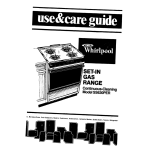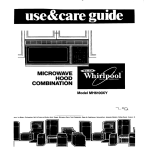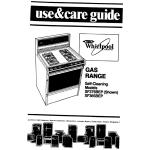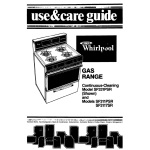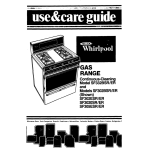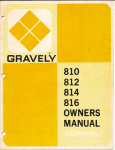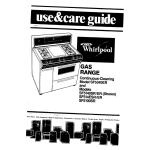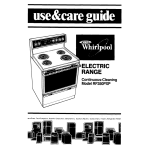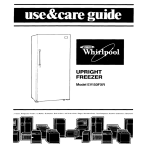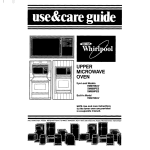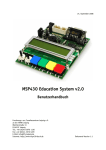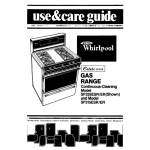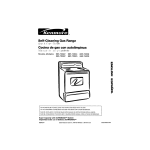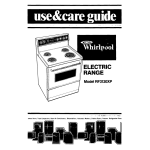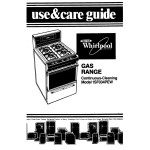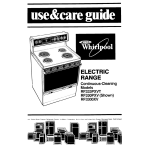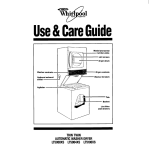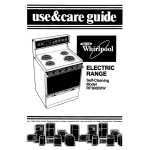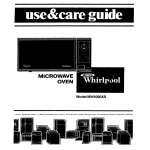Download Whirlpool SE960PEP User's Manual
Transcript
mn nmUGE - --Model SE960PEP ‘-‘“““‘- “‘=“‘, 114a11 cumPac~or*. noom AM Condltloners, Dehumldlflers, Automatic Washers, Clothes orvers. ~~~~~~~~ P Contents Page BEFORE YOU USE YOUR RANGE 2 IMPORTANT SAFETY INSTRUCTIONS. . 3 PARTS AND FEATURES 5 USING YOUR RANGE. 6 Using the Surface Burners 6 Setting the Clock 7 Using the Minute Timer 8 Using the Ovens. , . 8 Baking or Roasting 8 Broiling , 9 Using the Automatic MEALTIMER’ Clock 10 Oven Vent 11 Storage Drawer . 12 CARING FOR YOUR RANGE.. 13 oiyu/ wnrnpoor Control Panels Surface Burner Grates and Reflector Pans Surface Burners Removable Cooktop Upper Oven Rack Guides Continuous-Cleaning Upper Oven Self-Cleaning Lower Oven Cleaning Chart Cooktop Light Oven Lights IF YOU NEED SERVICE OR ASSISTANCE WHIRLPOOL RANGE WARRANTY Page 13 . 16 18 21 23 24 25 28 Corporanon Before you use your range Read and carefully follow packed wlfh your range. Read this Use 81Care Guide informafion. the “INSTALLATION and the Cooking INSTRUCTIONS” Guide for important 14 14 15 16 safety You are personally responsible for: l Reading and following all safety precautions in this Use & Care Guide and the Cooking Guide. l Having your range installed by a qualified installer. l Installing the range where it is protected from the elements, and on a level floor strong enough to hold its weight. l Having your range properly connected to electrical supply and grounded. (See “Installation Instructions:‘) l Having your range properly connected to the proper gas supply and checked for leaks. (See “Installation Instructions!‘) l Making sure the range is not used by children or anyone unable to operate it properly. l Properly maintaining your range. l Using the range only for jobs expected of a home range. See “Cooking Guide” for important safety and use information. IMPORTANT SAFETY INSTRUCTIONS 1. DO NOT allow play with any or leave them it. They could injured. children to use or part of the range, unattended near be burned or 6. KEEP pan handles turned in, but not over another surface burner to prevent burns, injury and to help prevent the utensil from being pushed off the cooktop. 2. DO NOT store things children might want above the range. Children could be burned or injured while climbing on it. 7. DO NOT use water on grease fires. The fire will spread. Cover fire with large lid or smother with baking soda or salt. 3. DO NOT allow anyone to touch a hot surface burner, oven burner or areas around them. They could be hot enough to burn severely. 8. 4. KEEP children away from the range when it is on. The cooktop, oven walls, racks and door can be hot enough to cause burns. 9. DO NOT heat unopened containers. They could explode. The hot contents could burn and container particles could cause injury. 5. DO NOT use a range to heat a room. Persons in the room could be burned or injured, or a fire could start. 10. DO NOT wear loose or hanging garments when using the range. They could ignite if they touch a hot burner or surrounding area and you could be burned. When adding or removing food, MAKE SURE to open the oven door all the way to prevent burns. continued on next page 11. DO NOT use a wet pot holder. Steam burns can result. DO NOT use a towel or bulky cloth as a pot holder. They could catch fire and burn you. 12. MAKE SURE the utensils you use are large enough to contain food and avoid boil overs and spillovers. This will help prevent hazardous build-ups of food. Heavy splattering or spillovers left on a range can ignite and burn you. Pan size is especially important in deep fat frying. 14. GREASE is flammable and should be handled carefully. Let fat cool before attempting to handle it. Do not allow grease to collect around range or in vents. Wipe spillovers immediately. 15. NEVER use a match or other flame to look for a gas leak. Explosion and injury could result. 16. DO NOT repair or replace any parts unless specifically recommended in this manual. All other servicing should be referred to a qualified service technician. 13. DO NOT leave surface burners on high heat settings. Boil overs and greasy spillovers could cause steam, smoke and could ignite and burn you. . FOR YOUR SAFETY l DO NOT STORE OR USE GASOLINE OR OTHER FLAMMABLE VAPORS AND LIQUIDS IN THE VICINITY OF THIS OR ANY OTHER APPLIANCE. THEY COULD IGNITE CAUSING EXPLOSION AND/OR FIRE. - SAW THESE INSTRUCTIONS Copy your Model and Serial Numbers here... If you need service, or call with a question, have this information ready: 1. Complete Model and Serial Numbers (from the plate located as shown). 2. Purchase date from sales slip. 4 Model Number Serial Number Copy this information in these spaces. Keep this book, your warranty and sales slip together in a handy place. Purchase Please complete and mall the Owner furnlshed with thls product. Registration Servlce Date Company Card Phone Number - Parts and features Model SE960PEP MINUTE TIMER DIGITAL CLOCK \ --..-.....-..a / STOP TIME / STARTTA G \ y - i LOWER OVEN \ SIGNAL LIGHT v SELF-CLEAN LIGHT: UPPER OVEN / SIGNAL LIGHT GRATES AND CHROME REFLECTOR PANS UPPER OVEN / TEMPERATURE CONTROL MODEL AND SERIAL NUMBER PLATE OVEN VENT ’ SURFACE / SURFACE BURNER AND LOWER OVEN CONTROLS OVEN RACK GUIDE BLANKEI-O-FLAME” /\ 11 REMOVABLE / STORAGE DRAWER LITERATURE PAC (not shown) SELF-CLEANING OVEN I LOCK LEVER I REMOVABLE OVEN DOOR \\ OVEN BURNER Using your range TOP LIGHT SWITCH I / / LEFl FRONT CONTROL KNOB OVEN LIGHT OVEN SELECTOR LOWER OVEN TEMPERATURE CONTROL \ I LEFl REAR CONTROL KNOB SURFACE BURNER INDICATORS RIGHT REAR CONTROL KNOB \ RIGHT FRONT CONTROL KNOB Using the Surface Burners Surface Burner Indicators The solid dot in the surface burner indicator shows which surface burner is turned on by that knob. Control knobs must be pushed in, then turned to the LITE position. The clicking sound is the ignition sparking. To stop the clicking sound after the burner lights, turn the control knob back to a desired setting. The control knob has stops for HI, MED and LOW, however it can be set anywhere between HI and OFF. Do not cook with the control in the LITE position. In Case of a Prolonged Power Failure Surface burners can be manually lighted. Hold a lighted match near a burner and turn the control to the LITE position. After the burner lights, turn the control to the desired setting. See the “Cooking Guide” for important utensil information. Until you get used to the settings, use the following as a guide: Use LITE to light the burner. Afler the burner lights, turn control back to a desired setting to stop the clicking of the ignition. Do not cook with the control In the LITE position. Use HI to start foods cooking or to bring liquids to a boil. Use MED to continue cooking or to fry chicken or pancakes; for gravy, puddings and icing or to cook large amounts of vegetables. Use LOW to keep foods warm until ready to serve. Setting the Clock Push in and turn the Minute 1. mmer Knob to set the Clock. Push in Minute Timer Knob and furn clockwise until clock shows the right time of day. Let the Minute Timer Knob pop out. Turn clockwise until Minute Timer hand points to OFF. The clock setting will change if you push in the knob when turning. Using the Minute Tiier The Minute Timer does not start or stop the oven. It works like a kitchen timer. Set it in minutes up to an hour, You will hear a buzzer when the set time is up. DO NOT PUSH IN THE KNOB when setting the Minute Timer. 1. Wlthouf pushing if in, turn the Minute Timer Knob until the hand passes the setting you want. 2. Without pushing in, turn the knob back to the setting you want. When the time is up, a buzzer will sound. To stop the buzzer, turn the Minute Timer hand to OFF. PUSHING IN AND TURNING THE MINUTE TIMER KNOB CHANGES SETTING. THE CLOCK Using the ovens The lower oven is always set with two knobs: -The Oven Selector -The Lower Oven Temperature Control Both must be on a setting for the lower oven to heat. The upper oven is set with one knob only: -The Upper Oven Temperature Control The upper oven turns on when a temperature is selected. Baking or roasting Rack(s) should be placed so the top of the food will be centered in the oven. Always leave at least 1Y2to 2 inches (4-5 cm) between the sides of the pan and the oven walls and other pans. For more information, see the “Cooking Guide:’ 1. El Position the rack(s) properly before turning on the oven. To change rack poslfion, pull rack out to stop, raise front edge and lift out. 2. If you’re cooking in the lower oven, set the Oven Selector on BAKE and the Lower Oven Temperature Control on the baking temperature you want. The lower oven burner will automatically light in 50-60 seconds. 3. Preheat the oven. The oven is preheated when the Oven Signal Light first goes off. Note: Oven racks, walls and door will be hot. Do not place food directly on oven bottom. If you’re cooking in the upper oven, set the Upper Oven Temperature Control to the temperature you want. The upper oven burner will automatically liaht in 50-60 seconds. 4. During baking, the oven burner will turn on and off to maintain the temperature setting. The Oven Signal Light will turn on and off with the burner. When baking is done, turn both the Oven Selector and the Lower Oven Temperature Control to OFF for the lower oven, or turn the Upper Oven Temperature Control to OFF for the umber oven. Broilincr The Blanket-0-Flamet Broiler uses infra-red rays to cook the food. Infra-red rays create fast, searing heat and consume most smoke and spatters. Always broil with the oven door closed. 1. Position the rack before turning the oven on. See rack placement chart and broiling chart in the “Cooking Guide” for recommended rack positions. 2. Put the broiler pan and food on the rack and completely GlOXi the oven door. DO NOT PREHEAT THE BROILER BEFORE USING. 3. Set the Oven Selector and the Lower Oven Temperature Control to BROIL. The broiler will automatitally light in 5060 seconds. 4. When broiling is done,turn both the Oven Selector and the Oven Temperature Control to OFF DO NOT PREHEAT THE BROILER BEK)RE USING. CLOSE OVEN DOOR DURING BROILING. Using the Automatic MEALTIMER” Clock The automatic MEALTIMER’ Clock is designed to turn the oven on and off at times you set, even when you are not around. Automatic baking is ideal for foods which do not require a preheated oven such as meats and casseroles, Do not use the aufomafic cycle for cakes, cookies, efc...undercooking will result. To start and stop baking automatically: 1. Position the oven rack(s) properly, and place the food in the oven. 3. Push in and turn the Start Time Knob clockwlse to the time you want baking to start. 10 2. Turn the Set Time Knob until the Start and Stop Time Dials show the correct time of day. 6. Push in and turn the Stop Time Knob clockwise to the time you want the oven to shut off. 5. Set the Oven Selector BAKE. To start baking 1. Position rack(s) on TIMED 6. Set the Lower Oven Temperature Control on the baking temperature you want. The oven will now start and stop automatically. After baking is done or to sfop the oven before preset time, turn both the Oven Selector and the Lower Oven Temperature Control to OFF now and stop automatically: properly, and place the food in the oven. 2. Make sure the clock is set to the right time of day. 3. Push in and turn the Stop Time Knob clockwise to the time you want the oven to shut off. 4. Set the Oven Selector on TIMED BAKE. 5. Set the Oven Temperature Control on the baking temperature you want. 6. Affer baking is done or to stop the oven before the preset time, turn both the Oven Selector and the Oven Temperature Control to OFF The Oven Vent Hot air and moisture escape from the oven through a vent just under the cooktop light. Do not block vent. Poor baking will result. OVEN VENT ‘I The Storage Drawer The storage drawer is for storing pots and pans. Use care when handling Removing 1. the storage The edges the storage could be sharp. drawer Pull drawer straight out to the first stop. Lift front and pull out to the second stop. Replacing 1. the drawer. 2. Lift back slightly and slide drawer all the way out. drawer Fit ends of drawer slide rails into the drawer guides on both sides of opening. 2. Lift drawer front and push in until white stops on drawer slide rails clear white stops on drawer guides, then slide drawer closed. Use & Care Guide storage Store this booklet, along with your ‘Cooking Guide:’ sales slip and warranty in the Literature Pat, inside the storage drawer. I ” .’ Caring for your range Control Panels 1. Pull knobs straight off. 3. Wash knobs in warm soapy water or use baking soda and a damp, soft cloth. Rinse well and dry. CAUTION: Do not use abrasive cleansers. They could rub off the markings. 2. Use warm soapy water or baking soda and a damp soft cloth to wipe the control panels. Rinse and wipe dry 4. Push the knobs straight back on. Make sure they point to OFF: Surface Burner Grates and Reflector Pans 2. Lift off the grates and remove reflector pans. 3. Wash the grates and reflector pans in warm soapy water. Rinse and dry well. 4. Replace grates. reflector the pans and Surface Burners To remove the cooktop, follow the instructions on page 15. Wipe off surface burners with warm soapy water and a soft cloth after each use. Occasionally check surface burner flames for size and shape as shown. If flames do not burn properly, you may need to remove the burners for cleaning [see page 221, or call a qualified technician for adjustment. 14 Removable Cooktop 1. Remove Surface Burner Grates and Reflector Pans. 2. Lift front of cooktop enough to clear front of range. Grasp both sides of the cooktop, lift and pull forward to remove. 3. Wipe surface under the cooktop with warm soapy water. Use soapy steel-wool pad on stubborn spots. CAUTION: removlng. Do not drop the cooktop or let lt bump the upper oven when Damage could result to the portelaln and the oooktop frame. The Upper Oven Rack Guides Removing the upper oven burner cover, rack guides make it easier to clean the upper oven. Lift up the front of the burner cover and’pull out. and back wall will help 2. Lift up front of rack guide and swing out enough so the front tabs clear the notches in the oven wall. Pull the guide straight away from the back oven wall. 3. Pull out bottom tab on back wall, then remove. REVERSE THE PROCEDURE TO REPLACE BACK WALL AND RACK GUIDES. The Continuous-Cleaning Upper Oven Standard oven walls are coated with smooth porcelain enamel. Your continuous-cleaning oven walls are coated with a special, rougher porcelain enamel A fat spatter beads up on the smooth surface, but spreads out on the rougher surface. The bead of fat chars and turns black. The spread-out fat gradually burns away at medium to high baking temperatures (350 -475-R 176 -246 C) so the oven can return to a presentably clean condition. 16 I ” “’ Spillovers Sugar and starchy spills (from pies and casseroles] and soils which occur in heavy amounts will not be removed. After the oven is cooled, remove these spillovers with a nylon scrubbing pad and water. If the soil is really baked on, it can be loosened by using TOP JOB: HANDY ANDY,m or FANTASTIK.” Spray cleaner on the spot and let soak for about 15 minutes. Brush with a wet nylon scrubbing pad and rinse well with a wet sponge. CAUTION: Do not use toll or foil liner on the oven bottom. poor baking results and could damage the oven. Cleaning 1. It will cause Tips The oven window and racks are not coated. Clean them by hand. 2. The oven door does not get as hot as the walls. Some hand cleaning needed iand may Cleaning WINDOW-Keep clean with hot sudsy water. Use a plastic scouring pad for stubborn spots. Rinse Do not use steel-wool abrasive cleansers. ACKS - Use soapy steel-wool ad for best cleaning results. nse well. or WALLS AND DOOR-Wash with hot soapy water. Use a plastic scouring pad for stubborn spots. Rinse well. The Self-Cleaning Lower Oven The self-cleaning cycle uses very high heat to burn away soil. Before you start, make sure you understand exactly how to use the cycle safely, Before You Start 1. Clean the shaded areas bv hand. They do not get hot enough during the Self-Cleaning cycle for soil to burn away. Use hot water and detergent or a soapy steel wool pad on... l the frame around the oven. l the inside of the door, especially the part outside the oven seal. DO NOT clean the fiberglass seal. DO NOT move it or bend it. Poor cleaning and poor baking will result. 2. Remove the racks, broiler pan and any pots and pans you may have stored in the oven. They can’t stand the high heat. 3. Wipe out any loose soil or grease. This will help reduce smoke and possible flare-ups during the cleaning cycle. Oven racks and chrome retlector pans must not be cleaned in the oven. They will warp and discolor. DO NOT Clean Seal Clean Door Turn on the vent hood or other kitchen vent during the cleaning cycle. This will help remove smoke, odor and heat that are normal during the cycle. SPECIAL CAUTIONS: DO NOT use commercial oven cleaners in your oven. Damage the porcelain finish may occur, to DO NOT force the Lock Lever, you could bend or break it. The lever is designed to stay locked until the oven is cool enough to safely open. Wait until it moves freely. DO NOT use foil or other liners in the oven. During the cleaning cycle foil can burn or melt and damage the oven surface. 18 I ” Setting the Controls for Self-Cleaning Be sure the kitchen is ventilated during the Self-Cleaning cycle. remove normal smoke and heat odors from the room as quickly 1. Make sure the Clock, Start and Stop Times all have the right time of day. 3. Set the Oven Selector and Oven Temperature Controls to CLEAN. 5. After the Clean Cycle Is completed and the oven temperature has dropped below 500°F (260°C) the Clean Light goes off and the Lock Lever can be moved back to the COOK position, Do not foroe it, Wait until it moves easily. Turn the Oven Selector and Oven Temperature Controls to OFF. This will as possible. 2. Push in the Stop Time Knob and turn the hand clockwise 2-2% hours. l Use 2 hours for light soil. l Use 2Yz hours for moderate to heavy soil. 4. Move the Lock Lever to the CLEAN position. This will start the SelfCleaning Cycle. If the door is not completely closed or the lever is not all the way to the right, the cycle will not start. When the oven temperature exceeds normal baking temperatures, the oven door can’t be opened and the Lock Lever must not be moved. 6. After the oven is cool, wipe off any residue or ash witl cloth.Ifneeded,touch with cleaner or plastic pad. , Special Tips Keep the kitchen well ventilated during the cleaning cycle to help get rid of normal heat, odors and smoke. Clean the oven before it gets heavily soiled. Cleaning a very soiled oven takes longer and results in more smoke than usual If the cleaning cycle doesn’t get the oven as clean as you expected, the cycle may not have been set long enough or you may not have prepared the oven properly. Set the cleaning time longer the next time and hand clean areas noted on page 18. To stop the cleaning time: 1. cycle at any Push in and turn the Stop Time Knob clockwise until it points to the right time of day 2. Turn the Oven Selector and Oven Temperature Controls to OFF. When the oven temperature drops below 500°F (260°C) the Lock Lever can be moved to the COOK Position. Do not force it. Walt until it moves easily. How It Works During the self-cleaning cycle, the oven gets much hotter than it does for baking or broiling...approximately 875 F (468 C]. This heat breaks up grease and soil and burns it off The graph shows approximate temperatures and times during a self-cleaning cycle for 2Yz hours. SELF-CLEANING (Approximate CYCLE - 2Y2 HOUR SETTING Temperatures and limes] IOOO’F 538°C 800°F 427°C 600°F 316-c 400°F 204°C 200°F 93°C START Y2hr. I hr. 2 hrs. IV2 hrs. 2Vz hrs. 3 hrs. STOP Notice that the heating stops when the 2% hour setting is up, but that it takes longer for the oven to cool down enough to unlock. Cleaning Chart PART WHAT TO USE HOW TO CLEAN Exterior surfaces Soft cloth and warm soapy water or baking soda. Nylon or plastic scrubbing pad for stubborn spots, l l l Surface grafes burner Automatic dishwasher or warm soapy water and plastic scrubbing pad. l l l Chrome reflector pans Automatic dishwasher or warm soapy water and plastic scrubbing pad. Wipe off regularly when cooktop and lower oven are cool. Do not allow food contalnlng acids (such as vinegar, tomato, lemon juice or milk) to remain on surface. Acids will remove the glossy flnlsh. Do not use abraslve or harsh cleansers. Wash with other cooking utensils. Dry completely. Do not place In Self-Cleanlng Oven. Wash with other cooking utensils. . Do not place In Self-Cleanlng Oven. l continued on next page 21 l . : PART Surface HOW TO CLEAN WHAT TO USE burners Broiler pan and grld Warm soapy water, a plastic scrubbing pad, dishwashing detergent or a solution oft quart of boiling hot water and 2 tablespoons of DIP IT.R Warm soapy water and plastic scrubbing pad. Remove cooktop, see pagels. Wipe off spills immediately after burner has cooled. In case of stubborn stalns: l Remove burner from manifold with phillips screwdriver. l Soak in warm soapy water and wipe with plastic scrubbing pad and dishwashing detergent. If stain is still there, soak 20 minutes in boiling water and DIP IT” solutlon. Be sure the solution covers the whole burner. l Rinse and dry well. l If ports are clogged, clean with a straight pin. Do not enlarge or dlstori ports. Do not use a wooden toothpick. l Do not clean surface burner In dishwasher. l l Wash with other cooking utensils. Do not place in Self-Cleaning Oven. l l Control Control knobs panels Warm soapy soft cloth. water and Warm soapy water or baking soda, soft cloth and spray alass cleaner. Wash, rinse and dry well Do not soak. l l Wash, rinse and dry well. Follow directions provided cleaner. l l with Oven mcks Warm soapy water and plastic scrubbing pad. Wash, rinse and dry well. Use plastic scrubbing pad for stubborn areas. . Do not place In Self-Cleanlng Oven. The Intense heat could warp them. Oven door glass Spray glass cleaner; warm soapy water and soft cloth. l l sure oven Is cool. Follow directions provided cleaner. Wash, rinse and dry well. Make l l ContlnuousCleanlng Oven Self-Cleanlng Oven Warm, soapy water or l soapy scrubbing pad. Use TOP JOB,’ HANDY ANDY.’ or l FANTASTIK’ for sugar and starchy spills and baked on soil. Most fat spatters on the enamel lnterlor surface clean condltlon durlng opemtlons. For areas outside SelfCleaning area use warm soapy water or plastic scrubbing pad. l l l with Clean stubborn spots or stains. Rinse well with water Spray cleaner on spot and let soak for about15 minutes. Rinse Well with a wet sponge. Contlnuous-Cleanlng pofcelaln gradually reduce to a presentably normal baklng or roastlng Follow directions starting on page1 8, “Using the SelfCleaning Cycle:’ Do not use commercial oven cleaners. Do not use loll to llne the bottom of your Self-CleanIn Oven. I ” .’ The Cooktop Light The lop Light switch is on the left side of fhe front control panel. Rock the switch forward to turn ON the light. Rock the switch back to turn OFF the light. To replace: 2. With both hands, pull top of light cover towards you and lift it out of bottom support trim. Remove the screws and metal trim that supports the top of the light cover. The glass is heavy. Hold it securely. 3. Grasp the fluorescent tube at both ends. Roll bottom of tube toward the front until both ends come out of the receptacles. Replace with a 20-watt cool-white fluorescent tube. 4. With both hands, carefully fit the glass light cover into the bottom metal support trim. Then rotate the top of the light cover until it touches the contact stops. Replace the top support trim and screws. Turn electric power back on at the main power supply. 23 The Oven Lights Both oven lights will come on when you open the lower oven door. To turn both lights on when the lower oven door is closed, push the Oven light switch on the right side of the front control panel. Push it again and/or close the lower oven door to turn off the lights. Replacing the lower Oven light 2. Push up bulb cover, retainer and seal to clear bottom screws, then remove. Remove the top screws from the bulb cover and loosen the bottom screws. 3. Remove the light bulb from its socket. Replace with a 40-watt appliance bulb. 4. Replace bulb cover, retainer, seal and top screws. Tighten screws. Turn the power back on at the main power supply. 7 CAUTION: The bulb cover must be in place protects the bulb from breaking. when using the oven. The cover NOTE: Both Oven Lights will not work during Replacing the Upper Oven light Remove the light bulb from its socket. Replace with a 40-watt appliance bulb. 24 the self-cleaning cycle. If you need service or assistance, we suggest you follow these five steps: 1. Before calling for assistance... Performance problems often result from little things you can fix yourself without tools of any kind. It nothlng operates: l Is the range properly connected to gas and electrical supplies? (See “Installation Instructions:‘) l Have you checked the main fuse or circuit breaker box? l Is the flow of combustion and/or ventilation air to the range blocked? Do not block the air flow to and around the range. If the oven will not operate: l Is the Oven Selector turned to a setting (BAKE or BROIL, but not TIMED BAKE]? l Is the Oven Temperature Control turned to a temperature setting? If burner fails to light: l Is the range connected to electrical power? l Have you checked the main fuse or circuit breaker box? l Are burner ports clogged? (See page 22 .] If burner flames are uneven: l Are burner ports clogged? (See page 22 .) If burner tlames litt off ports, are yellow, or are noisy when turned off: l The air/gas mixture may be incorrect. (Call for service.) If burner makes a popping noise when ON: l Is the burner wet from washing? Let dry. If control knob(s) will not turn: l Did you push in before trying to turn? If soil is visible on ContinuousCleaning oven finish: l The special finish is designed to gradually reduce oven soil during normal baking or roasting. It is not designed to keep your oven spotless, only presentably clean. l The door is cooler than the oven walls. Soil will be more visible on the door than other areas in the oven. See page 17 for how to clean. l Sugar and starchy spills may leave stains. See page 17 for hand cleaning tips, If the Self-Cleaning Cycle will not operate: l Is the Oven Selector set on CLEAN and the Oven Temperature Control set on OFF? l Does the Start Time Dial show the correct time of day? l Is the Stop Time Dial set ahead to the time you want the cleaning cycle to stop? . Is the Lock Lever all the way to the right? If cooking results aren’t what you expected: l Is the range level? l Are you using pans recommended in the Cooking Guide? l Does the flame size fit the cooking utensil being used? (See the Cooklng Guide.] l If baking, have you allowed W2to 2 inches (4-5 cm) on all sides of the pans for air circulation? l Have you preheated the oven before cooking? continued on next page Are the pans the size called for in the recipe? l Are you following a tested recipe from a reliable source? l If broiling, have you completely closed the oven dooR Blanket-OFlame@ Broiler provides best cooking results with the oven door closed. l Do the cooking utensils have smooth, flat bottoms? See the Cooking Guide for more information on cooking problems and how to solve them. l 2. If vou need as&stance%. Call Whirlpool COOL-LINE” service assistance telephone number. Dial free from anywhere in the U.S.: 1-800-253-1301 and talk with one of our trained Consultants The Consultants can instruct you in how to obtain satisfactory operation from your appliance or, if service is necessary, recommend a qualified service company in your area. 3. If you need service*... Whirlpool has nationwide a network of fran- TECU-CARE L FFA~HISED SERVICE 1 TECH-CARE serv- are trained to fulfill the product warranty and provide after-warranty service, anywhere in the United States. To locate TECH-CARE service in your area, call our COOL-LINE service assistance telephone number (see Step 2) or look in your telephone directory Yellow Pages under: 26 4. If you have a problem*... Call our COOL-LINE service assistance telephone number (see Step 2) and talk with one of our Consultants, or if you prefer, write to: Mr. Robert Stanley Division Vice President Whirlpool Corporation 2000 US-33, North Benton Harbor, Ml 49022 5. If you need FSP‘ replacement parts?.. FSP is a registered trademark of Whirlpool Corporation for quality parts. Look for this symbol of quality whenever you need a replacement part for your Whirlpool appliance. FSP replacement parts will fit right and work right, because they are made to the same exacting specifications used to build every new Whirlpool appliance. To locate FSP replacement parts in your area, refer to Step 3 above or call the Whirlpool COOL-LINE service assistance number in Step 2. *If you must call or write, please provide: model number, serial number, date of purchase, and a complete description of the problem. This information is needed in order to better respond to your request for assistance. Notes 27 WHIRLPOOL MICROWAW RANGE PRODUCT OVEN/ W-TY LENGTH OF WARRANTY WHIRLPOOL FULL ONE-YEAR WARRANTY From Date of Purchase Replacement parts and repair labor to correct defects in materials or workmanship. Service must be provided by a franchised TECH-CARE’ service company. LIMITED FOUR-YEAR WARRANTY Second Through Fifth Year From Date of Purchase Replacement magnetron tube on microwave ovens if defective in materials or workmanship. WHIRLPOOL WILL PAY FOR WILL NOT PAY FOR A. Service calls to: 1. Correct the installation of the range product. 2. Instruct You how to use the range product. 3. Replace house fuses or correct house wiring or plumbing. 4. Replace owner accessible light bulbs. 6. Repairs when range product is used in other than normal, single-family household use. C. Pick up and deliver. This product is designed to be repaired in the home. D. Damage to range product caused by accident, misuse, fire, flood, acts of God or use of products not approved by Whirlpool. E. Any labor costs during the limited warranty. WHIRLPOOL CORPORATION SHALL NOT BE LIABLE FOR INCIDENTAL OR CONSEQUENTIAL DAMAGES. Some states do not allow the exclusion or limitation of incidental or consequential damages so this limitation or exclusion may not apply to you. This warranty gives You specific legal rights, and You may also have other rights which vary from state to state. Outside the United States, a different warranty may apply. For details, please contact Your franchised Whirlpool distributor or military exchange. Part No. TKirlpool 36-060679-03-O/4157743 Rev.A 01987 s. Aulomallc Washers, - Whirlpool Clothes Dryers, Corporation freezers. Refrigerator-Freezers. Printed Ice Makers, Dishwashers, Built-In Ovens in U.S.A. and Surface Units. Ranges. I




























